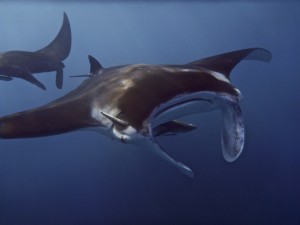Whales are not the only sea creatures that show off on the Great Barrier Reef by breeching in front of visitors. Manta rays do a great job of it too, putting on an acrobatic display before they return to the water.
There are two species of manta rays. The Manta birostris can grow to 7m and migrates across open oceans, while the smaller Manta alfredi grows to 5.5m and keeps to coastal waters. It is the smaller species which can be seen around Michaelmas Cay and the Passions of Paradise mooring at Paradise Reef.
Their large blanket-like shadow may give you a fright underwater, but these gentle creatures are harmless – they do not possess the sting of their close relative, the stingray. They also are related to sharks, yet that does not stop sharks from being their main predator.
Like sharks, manta rays have impressive rows of sharp teeth. These are not used for biting. Instead they are a filtration system for large quantities of zooplankton, which they swallow with their open mouths as they swim.
If that sounds like a clever way of eating, then maybe it has something to do with manta rays having the largest brain to body weight ratio of all sharks and rays.
The greatest threats to these magnificent creatures comes from human activities including pollution, entanglement in fishing nets, and direct harvesting for their gill rakers as an ingredient in Chinese medicine.
Manta rays are listed as ‘Vulnerable’ by the International Union for the Conservation of Nature (IUCN).
Environmental & Sustainability Coordinator
Passions of Paradise

